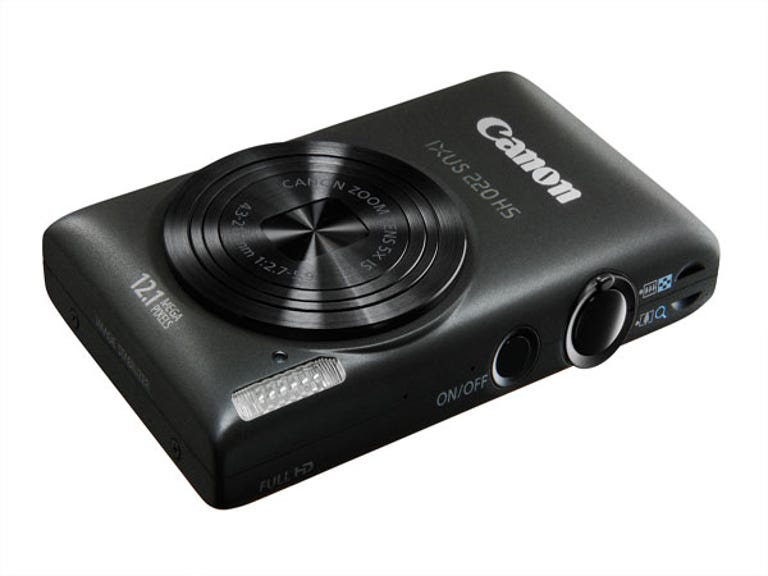 Why You Can Trust CNET
Why You Can Trust CNET Canon IXUS 220 HS review: Canon IXUS 220 HS
Canon delivers with the gorgeous 220 HS, a slimline compact camera that will suit every point-and-shoot enthusiast with a hankering for decent low-light shots.
Design and features
Canon has long been the doyen of the slimline, compact camera market, with previous offerings proving that style can walk hand-in-hand with photographic substance. This latest camera, the 220 HS, sits comfortably in a pocket thanks to its diminutive size and weight of 122g.
The Good
The Bad
The Bottom Line
It feels particularly nice to hold, and is surprisingly ergonomic despite its tiny footprint. Large hands shouldn't have too much trouble, as the buttons are significantly larger than on the previous slimline IXUS cameras that we've seen. The HS in the camera's title denotes "High Sensitivity", which comes thanks to a new 12.1-megapixel CMOS sensor and a range of in-camera options for better low-light performance. More on this later.
A 5x optical zoom pops out from the front of the chassis, with the lens opening to 24mm wide angle. At the rear, you get a 2.7-inch LCD screen with a fairly low resolution of 230,000-dots. Buttons sit flush with the back panel, including the mode selector switch that alternates between full automatic mode and various functions in program mode. There's also a dedicated video record button that flicks the 220 HS into its full HD, 1080p and 24fps recording mode.
Those functions include: movie digest mode, which takes four seconds of video before the shutter is pressed, stitching it together at the end of the day into a small VGA resolution movie; portrait; kids and pets; smart shutter; high-speed burst; best image selection, which takes the best image in a sequence; hand-held night scene; low-light mode, which takes images at a reduced 3-megapixel resolution; fish eye; miniature; and toy camera. There are plenty more modes to discover in the camera menus, just in case you didn't think these were enough.
Connectivity options are located underneath a small plastic flap on the side, covering a mini-HDMI and mini-USB port.
Performance
Canon rates the battery for 220 shots. The 220 HS can also shoot at 8fps in high-speed continuous mode, but the resolution drops to 3-megapixels.
Image quality
As the 220 HS is advertised as a camera that excels in low-light situations, we decided to put it through its paces. There are several modes in the camera that are designed specifically with evening photography in mind, including a long exposure mode with increments selectable up to a maximum of 15 seconds, and a mode that reduces the resolution to 3-megapixels.

An example of a shot taken using the low-light mode, reduced for web display.
(Credit: CBSi)
This camera does an excellent job of delivering strong, accurate colours even in low light, with deep blacks and reasonably natural skin tones produced with the flash turned on or off. The flash is also bright enough to illuminate both foreground and background subjects in a room. Autofocus is less accurate when the light drops off, so a few attempts might need to be made to lock the focus onto the appropriate subject.
We were able to capture this shot by using the long exposure setting at 1 second.
(Credit: CBSi)
While the 220 HS isn't going to replace the quality results delivered by a digital SLR when shooting at night or with long exposures, it certainly produces some of the best low-light images that we've seen from a compact. As would be expected, images look best when viewed at a reduced resolution for web or small print sizes. There is also a decent amount of noise visible on low-light images, which is to be expected as the ISO climbs.
As for images in normal, everyday situations, the 220 HS delivers the same punchy colour rendition that Canon is known for in its compact range. Photos look bright and vivid, with strong blues and reds in particular. Lens sharpness drops off towards the right-hand side of the frame, not uncommon on compact cameras, and there's a reasonable amount of distortion at the widest end. The camera also has a small tendency to blow out highlights in bright situations.
Video quality is good, with decent sharpness, although you cannot use the optical zoom while filming. The sound is reasonably clear, and voices can be picked up without too much difficulty in quiet situations.
Image samples
Exposure: 1/100, f/4.5, ISO 200 | Exposure: 1/640, f/2.7, ISO 100 |
Exposure: 1/15, f/4.5, ISO 400 | Exposure: 1/30, f/3.5, ISO 200 |
Conclusion
Canon delivers with the gorgeous 220 HS, a slimline compact camera that will suit every point-and-shoot enthusiast with a hankering for decent low-light shots.


